Aldi Group Marketing Strategies
VerifiedAdded on 2019/10/30
|12
|3047
|609
Report
AI Summary
This marketing report provides a comprehensive analysis of Aldi's marketing strategies, tracing its journey from a small private group to a leading European grocery retailer. The report details Aldi's core strategies, including its focus on exclusive brand products, restricted product range, and a low-price policy. It examines Aldi's value proposition and long-term approach, highlighting its commitment to quality despite low prices. The report also explores the competitive Australian grocery market and suggests strategic marketing options for Aldi's future growth, such as incorporating online shopping, loyalty programs, and catering to Australia's diverse cultural landscape. The conclusion emphasizes the need for Aldi to adapt its strategies to maintain its market share in an increasingly competitive environment.
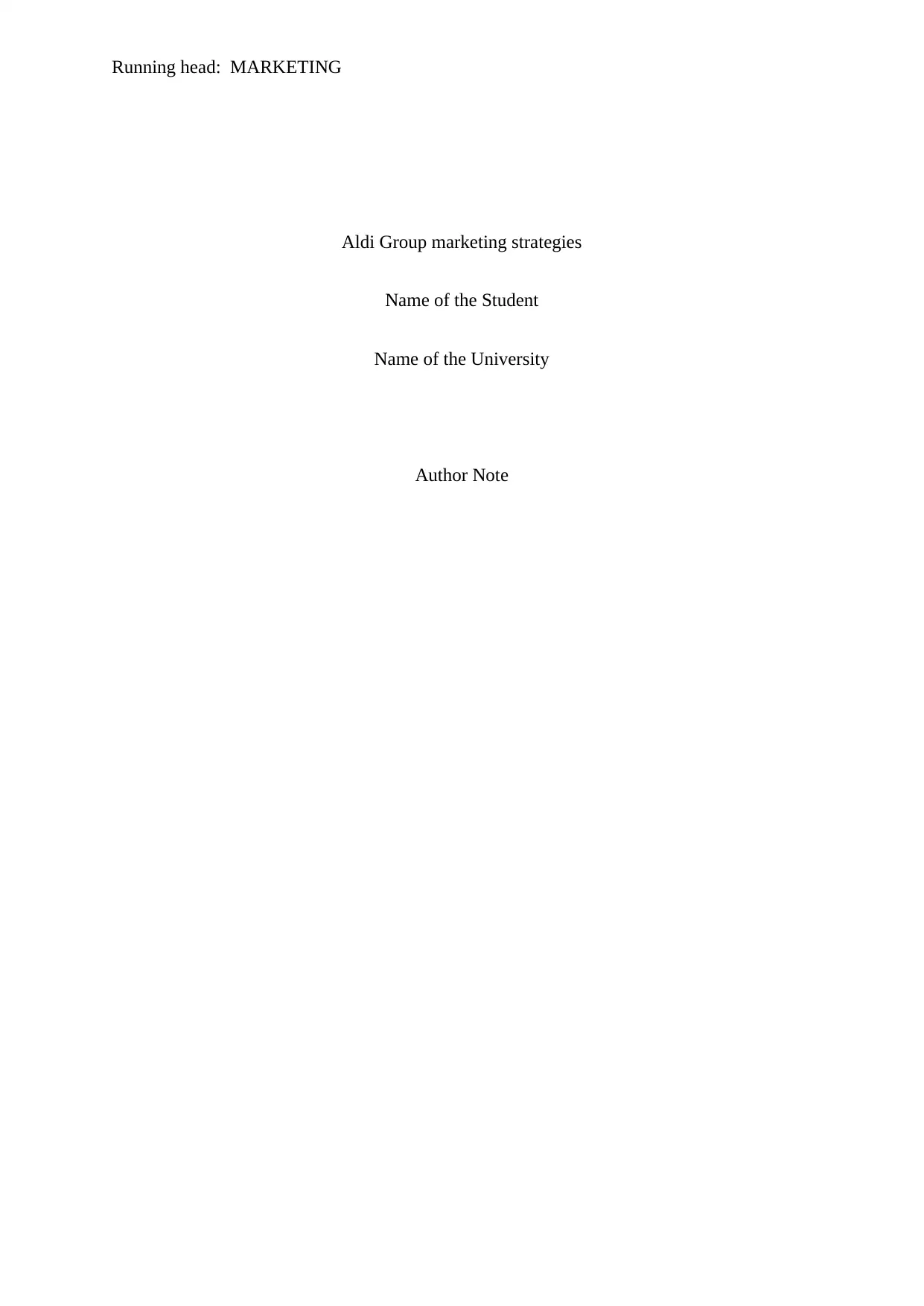
Running head: MARKETING
Aldi Group marketing strategies
Name of the Student
Name of the University
Author Note
Aldi Group marketing strategies
Name of the Student
Name of the University
Author Note
Paraphrase This Document
Need a fresh take? Get an instant paraphrase of this document with our AI Paraphraser

1
MARKETING
Executive summary
This report deals with the marketing strategy that Aldi follows from its time of origin and
there has been some suggested marketing options that can make way for Aldi to move
forward in this increasing competitive market. Aldi originated in 1913, with its headquarters
in Germany and later expanded its business from being just a private group to the leading
grocery retailer of Europe. However, keeping the experience of Aldi in Australia it was seen
that Australian grocery supermarkets are highly concentrated as well as competitive. In 2001,
Aldi entered Australian grocery market and by 2004 it 83 stores over four states. Its
marketing strategy mainly focuses on how to deliver low cost products to the customers
without compromising with their quality. Lastly, it can be concluded by giving few options
that can enhance their market strategy further and that is they can start with some add on
services for their customers that can include the facility of online shopping. They can also
provide the customers with reward points and loyalty cards so that customers remain loyalty
to their brand and by increasing their products keeping in mind culturally diverse customers.
MARKETING
Executive summary
This report deals with the marketing strategy that Aldi follows from its time of origin and
there has been some suggested marketing options that can make way for Aldi to move
forward in this increasing competitive market. Aldi originated in 1913, with its headquarters
in Germany and later expanded its business from being just a private group to the leading
grocery retailer of Europe. However, keeping the experience of Aldi in Australia it was seen
that Australian grocery supermarkets are highly concentrated as well as competitive. In 2001,
Aldi entered Australian grocery market and by 2004 it 83 stores over four states. Its
marketing strategy mainly focuses on how to deliver low cost products to the customers
without compromising with their quality. Lastly, it can be concluded by giving few options
that can enhance their market strategy further and that is they can start with some add on
services for their customers that can include the facility of online shopping. They can also
provide the customers with reward points and loyalty cards so that customers remain loyalty
to their brand and by increasing their products keeping in mind culturally diverse customers.

2
MARKETING
Table of Contents
Introduction................................................................................................................................3
Background to the Company......................................................................................................3
Marketing Analysis....................................................................................................................4
The Nature of Aldi’s Marketing Strategy..............................................................................4
Strategic Marketing Options for Aldi moving forward..........................................................7
Conclusion..................................................................................................................................8
References................................................................................................................................10
MARKETING
Table of Contents
Introduction................................................................................................................................3
Background to the Company......................................................................................................3
Marketing Analysis....................................................................................................................4
The Nature of Aldi’s Marketing Strategy..............................................................................4
Strategic Marketing Options for Aldi moving forward..........................................................7
Conclusion..................................................................................................................................8
References................................................................................................................................10
⊘ This is a preview!⊘
Do you want full access?
Subscribe today to unlock all pages.

Trusted by 1+ million students worldwide

3
MARKETING
Introduction
Marketing is the management procedure via which the goods and the services proceed
from the concept to the consumer. Mainly marketing involves the coordination of the four
elements, which together is known as the 4P’s of marketing, and they are product, price,
place and the promotional strategy. However, marketing is built on thinking about the trading
in relation to the customer’s needs and their satisfaction. Organizations teach consumers why
they must select their products and services over the other competitive brands (Jobber and
Ellis-Chadwick 2012). The other important factor in marketing is its marketing strategy that
is the overall business plan that is required to reach the people and turn them into its
customers. However, the marketing strategy of any organization carries the organization’s
value proposition, the messages of key marketing, information regarding the target customer
and the high-level elements of that organization. Marketing strategy thus, helps the
organization in developing their products, helps in right pricing of their products, effective
distribution, and support the organization with marketing communication (Baker 2014). The
chosen organization is Aldi and based on the company this report has been prepared to
discuss about the background of the company, its marketing strategies since it came into
existence and the marketing options they will need to sustain and move forward in the
upcoming years.
Background to the Company
Aldi Group is the dominant chain of grocery store in Germany and is among the top
competitors in the international market of food industry. It was founded in 1913 by the two
brothers Theo and Karl Albrecht and was a private group then (Bain 2015). However, it
became successful as the Europe’s largest retailer as it went against practically every possible
quality of super marketing from the traditional reticence to its Spartan ambience of the stores.
MARKETING
Introduction
Marketing is the management procedure via which the goods and the services proceed
from the concept to the consumer. Mainly marketing involves the coordination of the four
elements, which together is known as the 4P’s of marketing, and they are product, price,
place and the promotional strategy. However, marketing is built on thinking about the trading
in relation to the customer’s needs and their satisfaction. Organizations teach consumers why
they must select their products and services over the other competitive brands (Jobber and
Ellis-Chadwick 2012). The other important factor in marketing is its marketing strategy that
is the overall business plan that is required to reach the people and turn them into its
customers. However, the marketing strategy of any organization carries the organization’s
value proposition, the messages of key marketing, information regarding the target customer
and the high-level elements of that organization. Marketing strategy thus, helps the
organization in developing their products, helps in right pricing of their products, effective
distribution, and support the organization with marketing communication (Baker 2014). The
chosen organization is Aldi and based on the company this report has been prepared to
discuss about the background of the company, its marketing strategies since it came into
existence and the marketing options they will need to sustain and move forward in the
upcoming years.
Background to the Company
Aldi Group is the dominant chain of grocery store in Germany and is among the top
competitors in the international market of food industry. It was founded in 1913 by the two
brothers Theo and Karl Albrecht and was a private group then (Bain 2015). However, it
became successful as the Europe’s largest retailer as it went against practically every possible
quality of super marketing from the traditional reticence to its Spartan ambience of the stores.
Paraphrase This Document
Need a fresh take? Get an instant paraphrase of this document with our AI Paraphraser
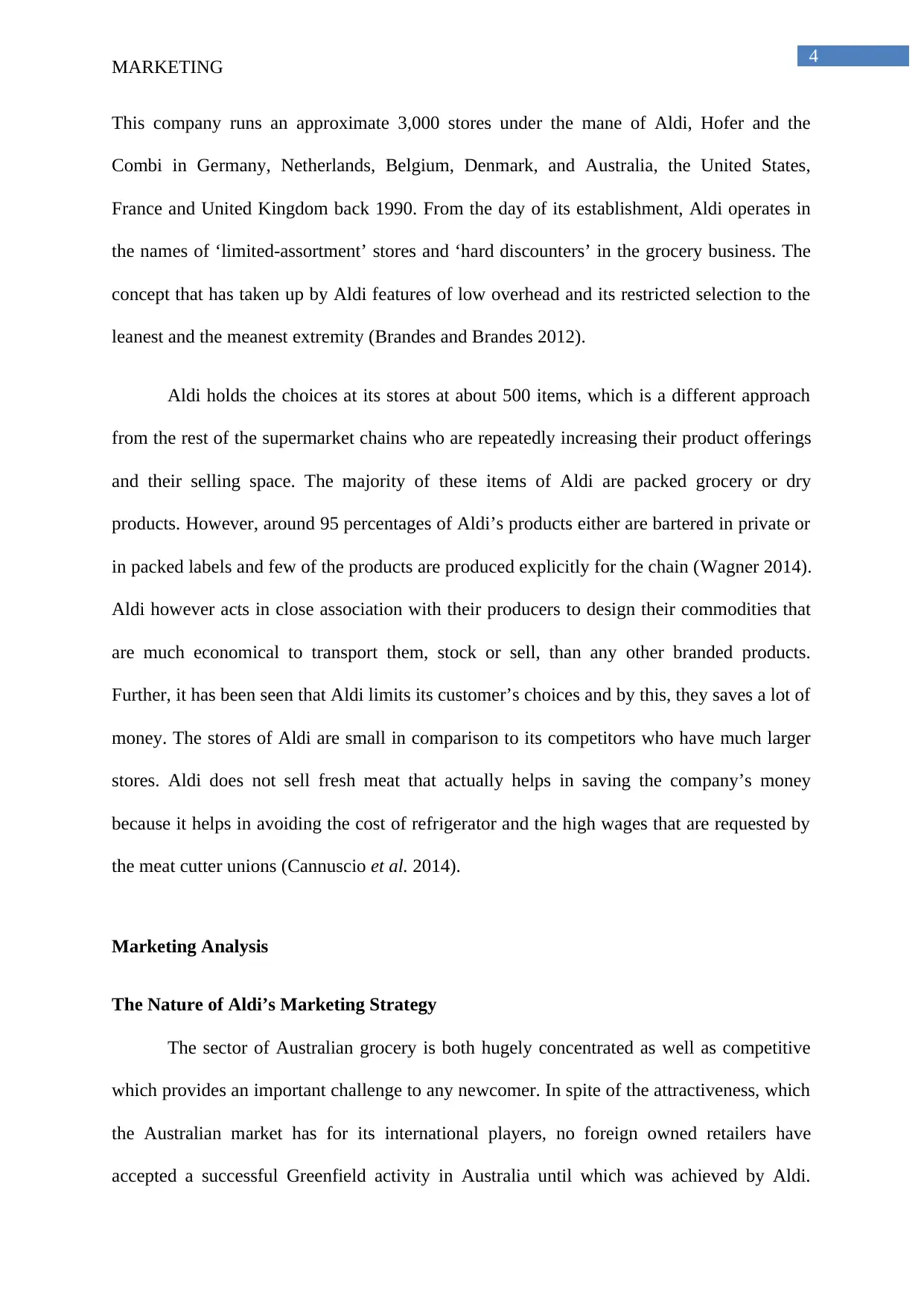
4
MARKETING
This company runs an approximate 3,000 stores under the mane of Aldi, Hofer and the
Combi in Germany, Netherlands, Belgium, Denmark, and Australia, the United States,
France and United Kingdom back 1990. From the day of its establishment, Aldi operates in
the names of ‘limited-assortment’ stores and ‘hard discounters’ in the grocery business. The
concept that has taken up by Aldi features of low overhead and its restricted selection to the
leanest and the meanest extremity (Brandes and Brandes 2012).
Aldi holds the choices at its stores at about 500 items, which is a different approach
from the rest of the supermarket chains who are repeatedly increasing their product offerings
and their selling space. The majority of these items of Aldi are packed grocery or dry
products. However, around 95 percentages of Aldi’s products either are bartered in private or
in packed labels and few of the products are produced explicitly for the chain (Wagner 2014).
Aldi however acts in close association with their producers to design their commodities that
are much economical to transport them, stock or sell, than any other branded products.
Further, it has been seen that Aldi limits its customer’s choices and by this, they saves a lot of
money. The stores of Aldi are small in comparison to its competitors who have much larger
stores. Aldi does not sell fresh meat that actually helps in saving the company’s money
because it helps in avoiding the cost of refrigerator and the high wages that are requested by
the meat cutter unions (Cannuscio et al. 2014).
Marketing Analysis
The Nature of Aldi’s Marketing Strategy
The sector of Australian grocery is both hugely concentrated as well as competitive
which provides an important challenge to any newcomer. In spite of the attractiveness, which
the Australian market has for its international players, no foreign owned retailers have
accepted a successful Greenfield activity in Australia until which was achieved by Aldi.
MARKETING
This company runs an approximate 3,000 stores under the mane of Aldi, Hofer and the
Combi in Germany, Netherlands, Belgium, Denmark, and Australia, the United States,
France and United Kingdom back 1990. From the day of its establishment, Aldi operates in
the names of ‘limited-assortment’ stores and ‘hard discounters’ in the grocery business. The
concept that has taken up by Aldi features of low overhead and its restricted selection to the
leanest and the meanest extremity (Brandes and Brandes 2012).
Aldi holds the choices at its stores at about 500 items, which is a different approach
from the rest of the supermarket chains who are repeatedly increasing their product offerings
and their selling space. The majority of these items of Aldi are packed grocery or dry
products. However, around 95 percentages of Aldi’s products either are bartered in private or
in packed labels and few of the products are produced explicitly for the chain (Wagner 2014).
Aldi however acts in close association with their producers to design their commodities that
are much economical to transport them, stock or sell, than any other branded products.
Further, it has been seen that Aldi limits its customer’s choices and by this, they saves a lot of
money. The stores of Aldi are small in comparison to its competitors who have much larger
stores. Aldi does not sell fresh meat that actually helps in saving the company’s money
because it helps in avoiding the cost of refrigerator and the high wages that are requested by
the meat cutter unions (Cannuscio et al. 2014).
Marketing Analysis
The Nature of Aldi’s Marketing Strategy
The sector of Australian grocery is both hugely concentrated as well as competitive
which provides an important challenge to any newcomer. In spite of the attractiveness, which
the Australian market has for its international players, no foreign owned retailers have
accepted a successful Greenfield activity in Australia until which was achieved by Aldi.
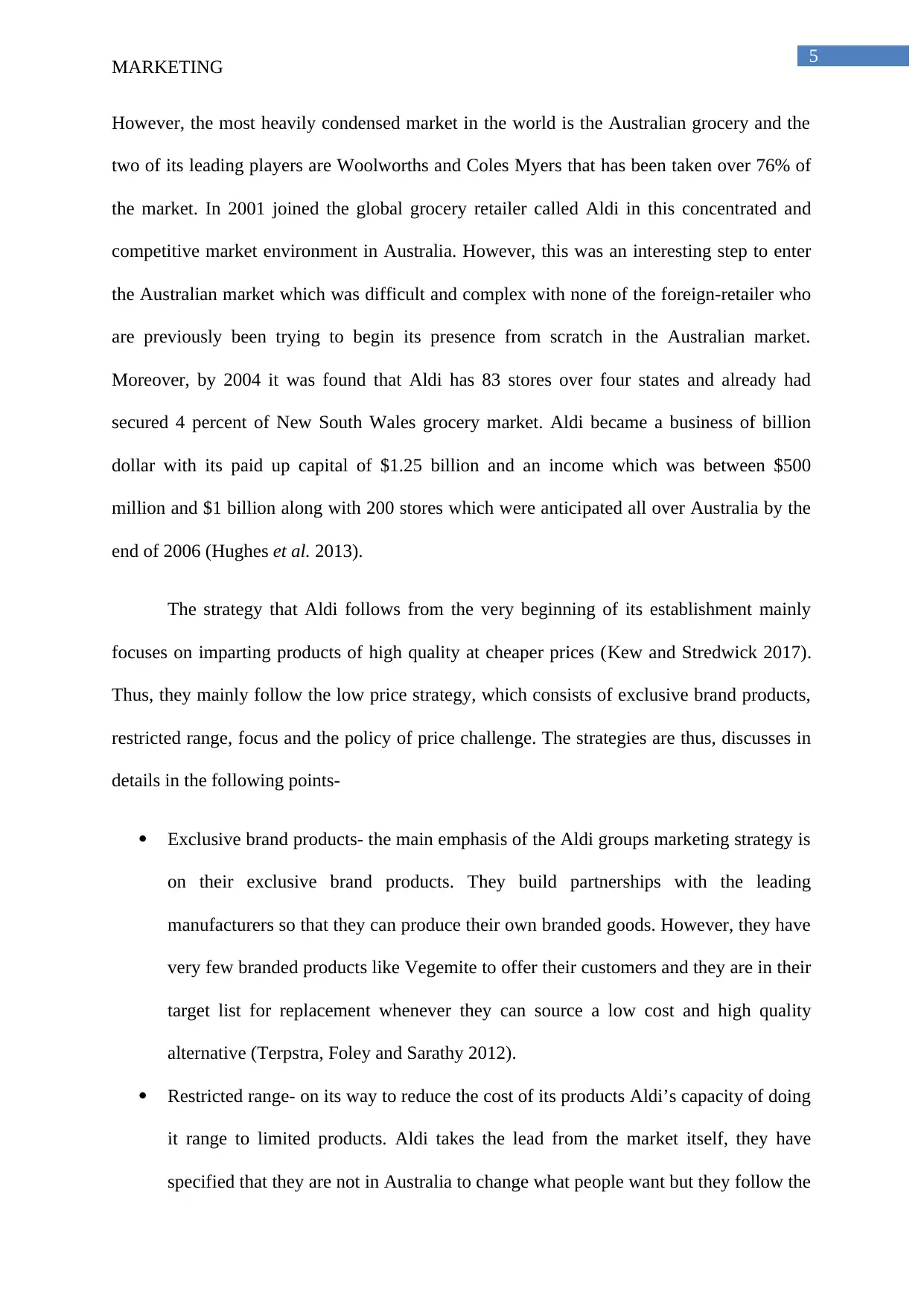
5
MARKETING
However, the most heavily condensed market in the world is the Australian grocery and the
two of its leading players are Woolworths and Coles Myers that has been taken over 76% of
the market. In 2001 joined the global grocery retailer called Aldi in this concentrated and
competitive market environment in Australia. However, this was an interesting step to enter
the Australian market which was difficult and complex with none of the foreign-retailer who
are previously been trying to begin its presence from scratch in the Australian market.
Moreover, by 2004 it was found that Aldi has 83 stores over four states and already had
secured 4 percent of New South Wales grocery market. Aldi became a business of billion
dollar with its paid up capital of $1.25 billion and an income which was between $500
million and $1 billion along with 200 stores which were anticipated all over Australia by the
end of 2006 (Hughes et al. 2013).
The strategy that Aldi follows from the very beginning of its establishment mainly
focuses on imparting products of high quality at cheaper prices (Kew and Stredwick 2017).
Thus, they mainly follow the low price strategy, which consists of exclusive brand products,
restricted range, focus and the policy of price challenge. The strategies are thus, discusses in
details in the following points-
Exclusive brand products- the main emphasis of the Aldi groups marketing strategy is
on their exclusive brand products. They build partnerships with the leading
manufacturers so that they can produce their own branded goods. However, they have
very few branded products like Vegemite to offer their customers and they are in their
target list for replacement whenever they can source a low cost and high quality
alternative (Terpstra, Foley and Sarathy 2012).
Restricted range- on its way to reduce the cost of its products Aldi’s capacity of doing
it range to limited products. Aldi takes the lead from the market itself, they have
specified that they are not in Australia to change what people want but they follow the
MARKETING
However, the most heavily condensed market in the world is the Australian grocery and the
two of its leading players are Woolworths and Coles Myers that has been taken over 76% of
the market. In 2001 joined the global grocery retailer called Aldi in this concentrated and
competitive market environment in Australia. However, this was an interesting step to enter
the Australian market which was difficult and complex with none of the foreign-retailer who
are previously been trying to begin its presence from scratch in the Australian market.
Moreover, by 2004 it was found that Aldi has 83 stores over four states and already had
secured 4 percent of New South Wales grocery market. Aldi became a business of billion
dollar with its paid up capital of $1.25 billion and an income which was between $500
million and $1 billion along with 200 stores which were anticipated all over Australia by the
end of 2006 (Hughes et al. 2013).
The strategy that Aldi follows from the very beginning of its establishment mainly
focuses on imparting products of high quality at cheaper prices (Kew and Stredwick 2017).
Thus, they mainly follow the low price strategy, which consists of exclusive brand products,
restricted range, focus and the policy of price challenge. The strategies are thus, discusses in
details in the following points-
Exclusive brand products- the main emphasis of the Aldi groups marketing strategy is
on their exclusive brand products. They build partnerships with the leading
manufacturers so that they can produce their own branded goods. However, they have
very few branded products like Vegemite to offer their customers and they are in their
target list for replacement whenever they can source a low cost and high quality
alternative (Terpstra, Foley and Sarathy 2012).
Restricted range- on its way to reduce the cost of its products Aldi’s capacity of doing
it range to limited products. Aldi takes the lead from the market itself, they have
specified that they are not in Australia to change what people want but they follow the
⊘ This is a preview!⊘
Do you want full access?
Subscribe today to unlock all pages.

Trusted by 1+ million students worldwide
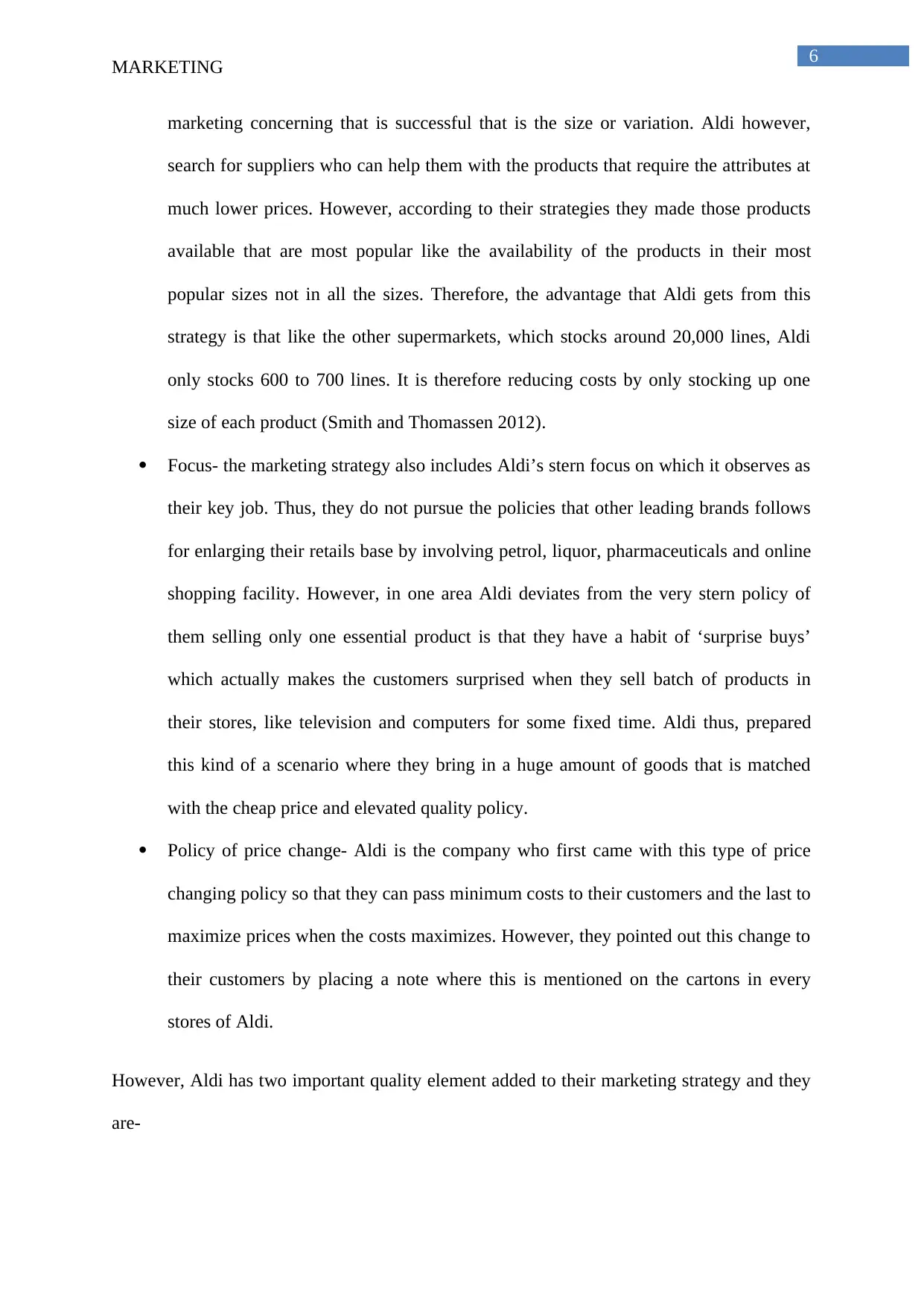
6
MARKETING
marketing concerning that is successful that is the size or variation. Aldi however,
search for suppliers who can help them with the products that require the attributes at
much lower prices. However, according to their strategies they made those products
available that are most popular like the availability of the products in their most
popular sizes not in all the sizes. Therefore, the advantage that Aldi gets from this
strategy is that like the other supermarkets, which stocks around 20,000 lines, Aldi
only stocks 600 to 700 lines. It is therefore reducing costs by only stocking up one
size of each product (Smith and Thomassen 2012).
Focus- the marketing strategy also includes Aldi’s stern focus on which it observes as
their key job. Thus, they do not pursue the policies that other leading brands follows
for enlarging their retails base by involving petrol, liquor, pharmaceuticals and online
shopping facility. However, in one area Aldi deviates from the very stern policy of
them selling only one essential product is that they have a habit of ‘surprise buys’
which actually makes the customers surprised when they sell batch of products in
their stores, like television and computers for some fixed time. Aldi thus, prepared
this kind of a scenario where they bring in a huge amount of goods that is matched
with the cheap price and elevated quality policy.
Policy of price change- Aldi is the company who first came with this type of price
changing policy so that they can pass minimum costs to their customers and the last to
maximize prices when the costs maximizes. However, they pointed out this change to
their customers by placing a note where this is mentioned on the cartons in every
stores of Aldi.
However, Aldi has two important quality element added to their marketing strategy and they
are-
MARKETING
marketing concerning that is successful that is the size or variation. Aldi however,
search for suppliers who can help them with the products that require the attributes at
much lower prices. However, according to their strategies they made those products
available that are most popular like the availability of the products in their most
popular sizes not in all the sizes. Therefore, the advantage that Aldi gets from this
strategy is that like the other supermarkets, which stocks around 20,000 lines, Aldi
only stocks 600 to 700 lines. It is therefore reducing costs by only stocking up one
size of each product (Smith and Thomassen 2012).
Focus- the marketing strategy also includes Aldi’s stern focus on which it observes as
their key job. Thus, they do not pursue the policies that other leading brands follows
for enlarging their retails base by involving petrol, liquor, pharmaceuticals and online
shopping facility. However, in one area Aldi deviates from the very stern policy of
them selling only one essential product is that they have a habit of ‘surprise buys’
which actually makes the customers surprised when they sell batch of products in
their stores, like television and computers for some fixed time. Aldi thus, prepared
this kind of a scenario where they bring in a huge amount of goods that is matched
with the cheap price and elevated quality policy.
Policy of price change- Aldi is the company who first came with this type of price
changing policy so that they can pass minimum costs to their customers and the last to
maximize prices when the costs maximizes. However, they pointed out this change to
their customers by placing a note where this is mentioned on the cartons in every
stores of Aldi.
However, Aldi has two important quality element added to their marketing strategy and they
are-
Paraphrase This Document
Need a fresh take? Get an instant paraphrase of this document with our AI Paraphraser
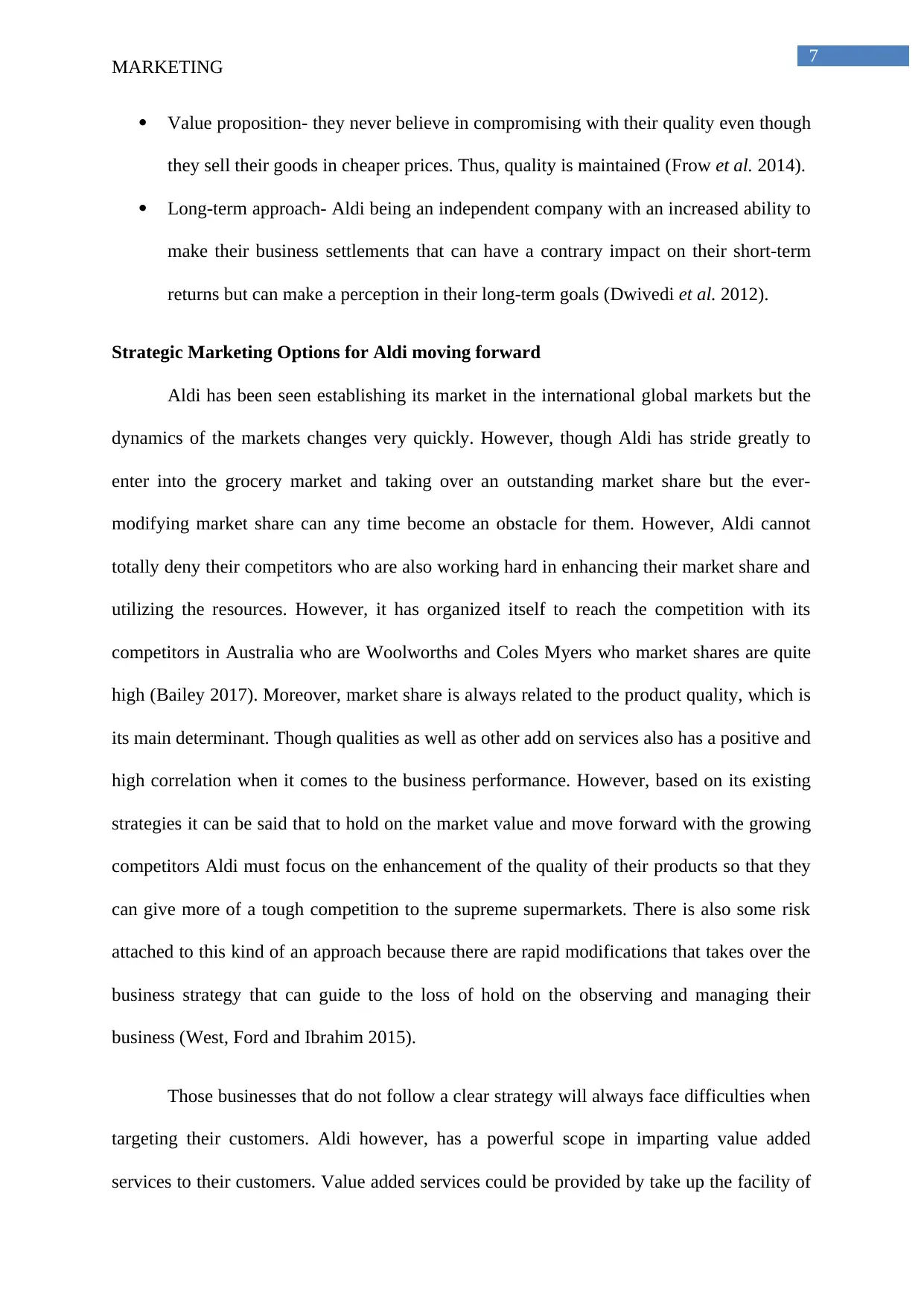
7
MARKETING
Value proposition- they never believe in compromising with their quality even though
they sell their goods in cheaper prices. Thus, quality is maintained (Frow et al. 2014).
Long-term approach- Aldi being an independent company with an increased ability to
make their business settlements that can have a contrary impact on their short-term
returns but can make a perception in their long-term goals (Dwivedi et al. 2012).
Strategic Marketing Options for Aldi moving forward
Aldi has been seen establishing its market in the international global markets but the
dynamics of the markets changes very quickly. However, though Aldi has stride greatly to
enter into the grocery market and taking over an outstanding market share but the ever-
modifying market share can any time become an obstacle for them. However, Aldi cannot
totally deny their competitors who are also working hard in enhancing their market share and
utilizing the resources. However, it has organized itself to reach the competition with its
competitors in Australia who are Woolworths and Coles Myers who market shares are quite
high (Bailey 2017). Moreover, market share is always related to the product quality, which is
its main determinant. Though qualities as well as other add on services also has a positive and
high correlation when it comes to the business performance. However, based on its existing
strategies it can be said that to hold on the market value and move forward with the growing
competitors Aldi must focus on the enhancement of the quality of their products so that they
can give more of a tough competition to the supreme supermarkets. There is also some risk
attached to this kind of an approach because there are rapid modifications that takes over the
business strategy that can guide to the loss of hold on the observing and managing their
business (West, Ford and Ibrahim 2015).
Those businesses that do not follow a clear strategy will always face difficulties when
targeting their customers. Aldi however, has a powerful scope in imparting value added
services to their customers. Value added services could be provided by take up the facility of
MARKETING
Value proposition- they never believe in compromising with their quality even though
they sell their goods in cheaper prices. Thus, quality is maintained (Frow et al. 2014).
Long-term approach- Aldi being an independent company with an increased ability to
make their business settlements that can have a contrary impact on their short-term
returns but can make a perception in their long-term goals (Dwivedi et al. 2012).
Strategic Marketing Options for Aldi moving forward
Aldi has been seen establishing its market in the international global markets but the
dynamics of the markets changes very quickly. However, though Aldi has stride greatly to
enter into the grocery market and taking over an outstanding market share but the ever-
modifying market share can any time become an obstacle for them. However, Aldi cannot
totally deny their competitors who are also working hard in enhancing their market share and
utilizing the resources. However, it has organized itself to reach the competition with its
competitors in Australia who are Woolworths and Coles Myers who market shares are quite
high (Bailey 2017). Moreover, market share is always related to the product quality, which is
its main determinant. Though qualities as well as other add on services also has a positive and
high correlation when it comes to the business performance. However, based on its existing
strategies it can be said that to hold on the market value and move forward with the growing
competitors Aldi must focus on the enhancement of the quality of their products so that they
can give more of a tough competition to the supreme supermarkets. There is also some risk
attached to this kind of an approach because there are rapid modifications that takes over the
business strategy that can guide to the loss of hold on the observing and managing their
business (West, Ford and Ibrahim 2015).
Those businesses that do not follow a clear strategy will always face difficulties when
targeting their customers. Aldi however, has a powerful scope in imparting value added
services to their customers. Value added services could be provided by take up the facility of
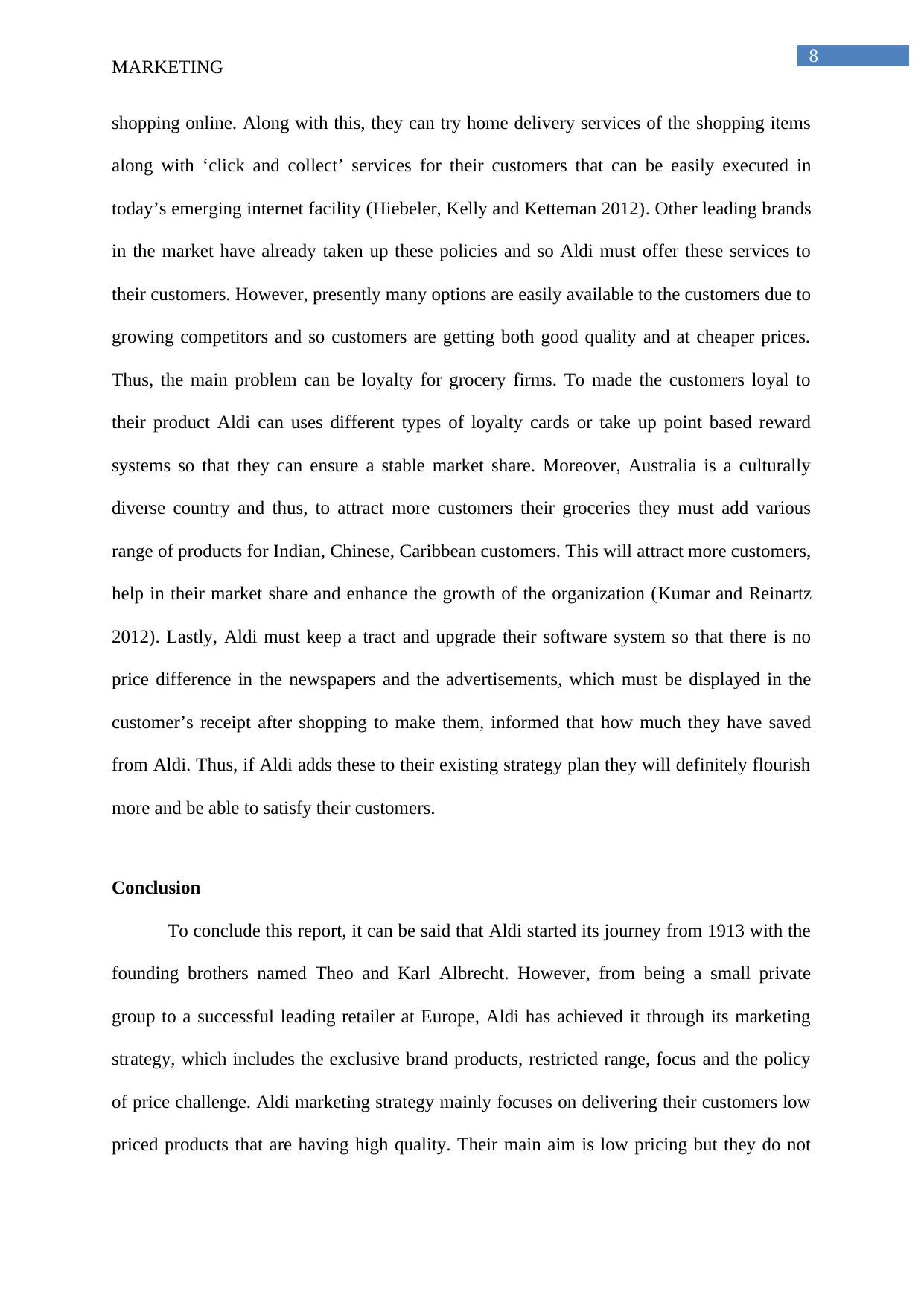
8
MARKETING
shopping online. Along with this, they can try home delivery services of the shopping items
along with ‘click and collect’ services for their customers that can be easily executed in
today’s emerging internet facility (Hiebeler, Kelly and Ketteman 2012). Other leading brands
in the market have already taken up these policies and so Aldi must offer these services to
their customers. However, presently many options are easily available to the customers due to
growing competitors and so customers are getting both good quality and at cheaper prices.
Thus, the main problem can be loyalty for grocery firms. To made the customers loyal to
their product Aldi can uses different types of loyalty cards or take up point based reward
systems so that they can ensure a stable market share. Moreover, Australia is a culturally
diverse country and thus, to attract more customers their groceries they must add various
range of products for Indian, Chinese, Caribbean customers. This will attract more customers,
help in their market share and enhance the growth of the organization (Kumar and Reinartz
2012). Lastly, Aldi must keep a tract and upgrade their software system so that there is no
price difference in the newspapers and the advertisements, which must be displayed in the
customer’s receipt after shopping to make them, informed that how much they have saved
from Aldi. Thus, if Aldi adds these to their existing strategy plan they will definitely flourish
more and be able to satisfy their customers.
Conclusion
To conclude this report, it can be said that Aldi started its journey from 1913 with the
founding brothers named Theo and Karl Albrecht. However, from being a small private
group to a successful leading retailer at Europe, Aldi has achieved it through its marketing
strategy, which includes the exclusive brand products, restricted range, focus and the policy
of price challenge. Aldi marketing strategy mainly focuses on delivering their customers low
priced products that are having high quality. Their main aim is low pricing but they do not
MARKETING
shopping online. Along with this, they can try home delivery services of the shopping items
along with ‘click and collect’ services for their customers that can be easily executed in
today’s emerging internet facility (Hiebeler, Kelly and Ketteman 2012). Other leading brands
in the market have already taken up these policies and so Aldi must offer these services to
their customers. However, presently many options are easily available to the customers due to
growing competitors and so customers are getting both good quality and at cheaper prices.
Thus, the main problem can be loyalty for grocery firms. To made the customers loyal to
their product Aldi can uses different types of loyalty cards or take up point based reward
systems so that they can ensure a stable market share. Moreover, Australia is a culturally
diverse country and thus, to attract more customers their groceries they must add various
range of products for Indian, Chinese, Caribbean customers. This will attract more customers,
help in their market share and enhance the growth of the organization (Kumar and Reinartz
2012). Lastly, Aldi must keep a tract and upgrade their software system so that there is no
price difference in the newspapers and the advertisements, which must be displayed in the
customer’s receipt after shopping to make them, informed that how much they have saved
from Aldi. Thus, if Aldi adds these to their existing strategy plan they will definitely flourish
more and be able to satisfy their customers.
Conclusion
To conclude this report, it can be said that Aldi started its journey from 1913 with the
founding brothers named Theo and Karl Albrecht. However, from being a small private
group to a successful leading retailer at Europe, Aldi has achieved it through its marketing
strategy, which includes the exclusive brand products, restricted range, focus and the policy
of price challenge. Aldi marketing strategy mainly focuses on delivering their customers low
priced products that are having high quality. Their main aim is low pricing but they do not
⊘ This is a preview!⊘
Do you want full access?
Subscribe today to unlock all pages.

Trusted by 1+ million students worldwide

9
MARKETING
believe in compromising with their product quality. However, their marketing strategy has
made them spread their business globally in Germany, Netherlands, Belgium, Denmark,
Australia, the United States, France and United Kingdom. Thus, there are two of its quality
elements that are added in their market strategy which are value proposition and long-term
approach. Moreover, with the growing competition and increasing options for the customers
in the market it is important for Aldi to make some changes in their market strategy that can
help them move forward with the time. Some of the options may be that they can attract
customers by starting the facility of online shopping, reward points as well as increasing
products keeping in mind the culturally diverse customers.
MARKETING
believe in compromising with their product quality. However, their marketing strategy has
made them spread their business globally in Germany, Netherlands, Belgium, Denmark,
Australia, the United States, France and United Kingdom. Thus, there are two of its quality
elements that are added in their market strategy which are value proposition and long-term
approach. Moreover, with the growing competition and increasing options for the customers
in the market it is important for Aldi to make some changes in their market strategy that can
help them move forward with the time. Some of the options may be that they can attract
customers by starting the facility of online shopping, reward points as well as increasing
products keeping in mind the culturally diverse customers.
Paraphrase This Document
Need a fresh take? Get an instant paraphrase of this document with our AI Paraphraser

10
MARKETING
References
Bailey, M., 2017. Absorptive Capacity, International Business Knowledge Transfer, and
Local Adaptation: Establishing Discount Department Stores in Australia. Australian Ec
Bain, D., 2015. The top 500 family businesses in the world.
Baker, M.J., 2014. Marketing strategy and management. Palgrave Macmillan.
Brandes, D. and Brandes, N., 2012. Bare essentials: the Aldi way to retail success. BoD–
Books on Demand.
Cannuscio, C.C., Hillier, A., Karpyn, A. and Glanz, K., 2014. The social dynamics of healthy
food shopping and store choice in an urban environment. Social Science & Medicine, 122,
pp.13-20.
Dwivedi, A., Merrilees, B., Miller, D. and Herington, C., 2012. Brand, value and relationship
equities and loyalty-intentions in the Australian supermarket industry. Journal of Retailing
and Consumer Services, 19(5), pp.526-536.
Frow, P., McColl-Kennedy, J.R., Hilton, T., Davidson, A., Payne, A. and Brozovic, D., 2014.
Value propositions: A service ecosystems perspective. Marketing Theory, 14(3), pp.327-351.
Hiebeler, R., Kelly, T. and Ketteman, C., 2012. Best practices: Building your business with
customer-focused solutions. Simon and Schuster.
Hughes, C., Wellard, L., Lin, J., Suen, K.L. and Chapman, K., 2013. Regulating health claims
on food labels using nutrient profiling: what will the proposed standard mean in the
Australian supermarket?. Public health nutrition, 16(12), pp.2154-2161.
MARKETING
References
Bailey, M., 2017. Absorptive Capacity, International Business Knowledge Transfer, and
Local Adaptation: Establishing Discount Department Stores in Australia. Australian Ec
Bain, D., 2015. The top 500 family businesses in the world.
Baker, M.J., 2014. Marketing strategy and management. Palgrave Macmillan.
Brandes, D. and Brandes, N., 2012. Bare essentials: the Aldi way to retail success. BoD–
Books on Demand.
Cannuscio, C.C., Hillier, A., Karpyn, A. and Glanz, K., 2014. The social dynamics of healthy
food shopping and store choice in an urban environment. Social Science & Medicine, 122,
pp.13-20.
Dwivedi, A., Merrilees, B., Miller, D. and Herington, C., 2012. Brand, value and relationship
equities and loyalty-intentions in the Australian supermarket industry. Journal of Retailing
and Consumer Services, 19(5), pp.526-536.
Frow, P., McColl-Kennedy, J.R., Hilton, T., Davidson, A., Payne, A. and Brozovic, D., 2014.
Value propositions: A service ecosystems perspective. Marketing Theory, 14(3), pp.327-351.
Hiebeler, R., Kelly, T. and Ketteman, C., 2012. Best practices: Building your business with
customer-focused solutions. Simon and Schuster.
Hughes, C., Wellard, L., Lin, J., Suen, K.L. and Chapman, K., 2013. Regulating health claims
on food labels using nutrient profiling: what will the proposed standard mean in the
Australian supermarket?. Public health nutrition, 16(12), pp.2154-2161.
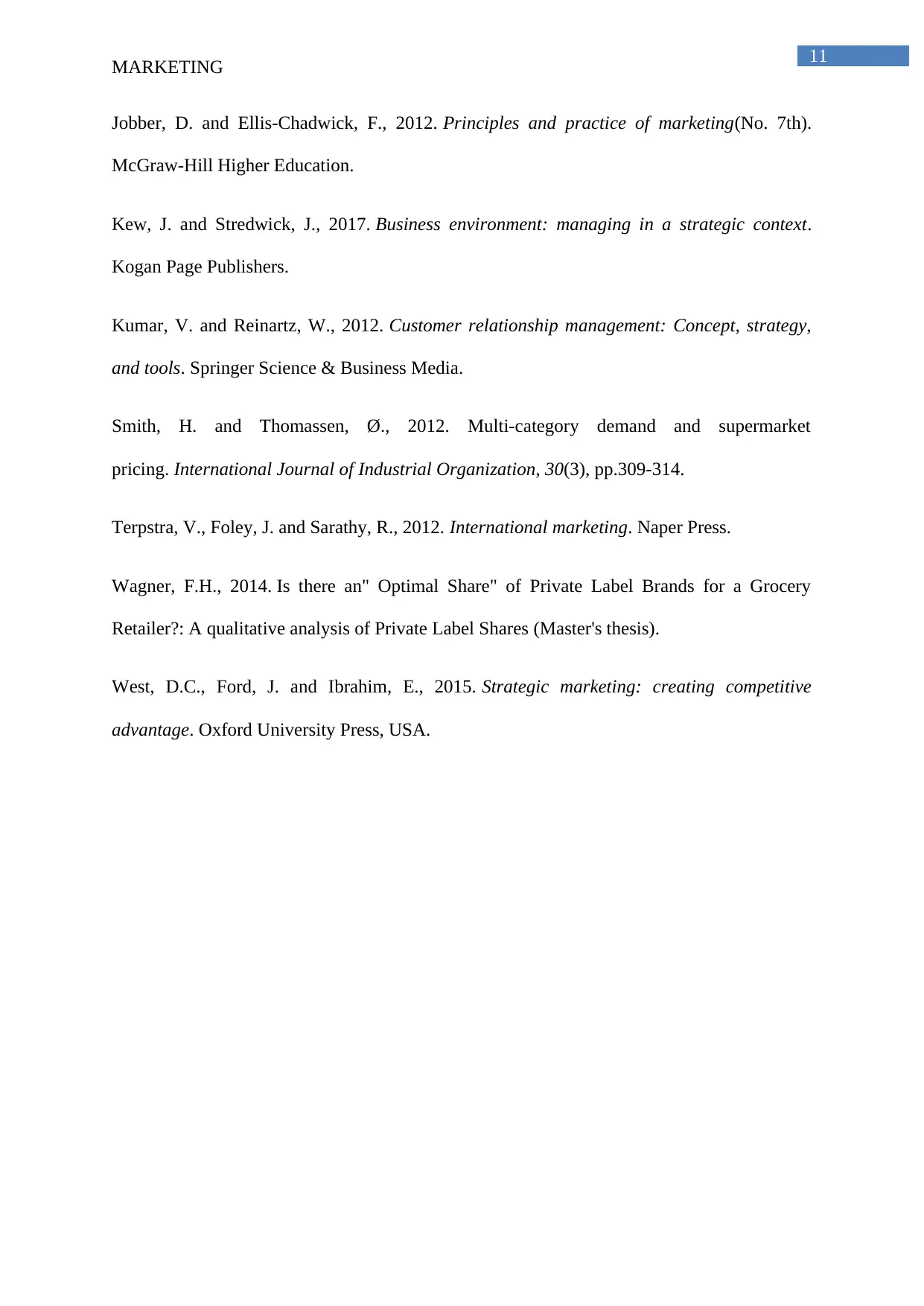
11
MARKETING
Jobber, D. and Ellis-Chadwick, F., 2012. Principles and practice of marketing(No. 7th).
McGraw-Hill Higher Education.
Kew, J. and Stredwick, J., 2017. Business environment: managing in a strategic context.
Kogan Page Publishers.
Kumar, V. and Reinartz, W., 2012. Customer relationship management: Concept, strategy,
and tools. Springer Science & Business Media.
Smith, H. and Thomassen, Ø., 2012. Multi-category demand and supermarket
pricing. International Journal of Industrial Organization, 30(3), pp.309-314.
Terpstra, V., Foley, J. and Sarathy, R., 2012. International marketing. Naper Press.
Wagner, F.H., 2014. Is there an" Optimal Share" of Private Label Brands for a Grocery
Retailer?: A qualitative analysis of Private Label Shares (Master's thesis).
West, D.C., Ford, J. and Ibrahim, E., 2015. Strategic marketing: creating competitive
advantage. Oxford University Press, USA.
MARKETING
Jobber, D. and Ellis-Chadwick, F., 2012. Principles and practice of marketing(No. 7th).
McGraw-Hill Higher Education.
Kew, J. and Stredwick, J., 2017. Business environment: managing in a strategic context.
Kogan Page Publishers.
Kumar, V. and Reinartz, W., 2012. Customer relationship management: Concept, strategy,
and tools. Springer Science & Business Media.
Smith, H. and Thomassen, Ø., 2012. Multi-category demand and supermarket
pricing. International Journal of Industrial Organization, 30(3), pp.309-314.
Terpstra, V., Foley, J. and Sarathy, R., 2012. International marketing. Naper Press.
Wagner, F.H., 2014. Is there an" Optimal Share" of Private Label Brands for a Grocery
Retailer?: A qualitative analysis of Private Label Shares (Master's thesis).
West, D.C., Ford, J. and Ibrahim, E., 2015. Strategic marketing: creating competitive
advantage. Oxford University Press, USA.
⊘ This is a preview!⊘
Do you want full access?
Subscribe today to unlock all pages.

Trusted by 1+ million students worldwide
1 out of 12
Related Documents
Your All-in-One AI-Powered Toolkit for Academic Success.
+13062052269
info@desklib.com
Available 24*7 on WhatsApp / Email
![[object Object]](/_next/static/media/star-bottom.7253800d.svg)
Unlock your academic potential
Copyright © 2020–2025 A2Z Services. All Rights Reserved. Developed and managed by ZUCOL.





